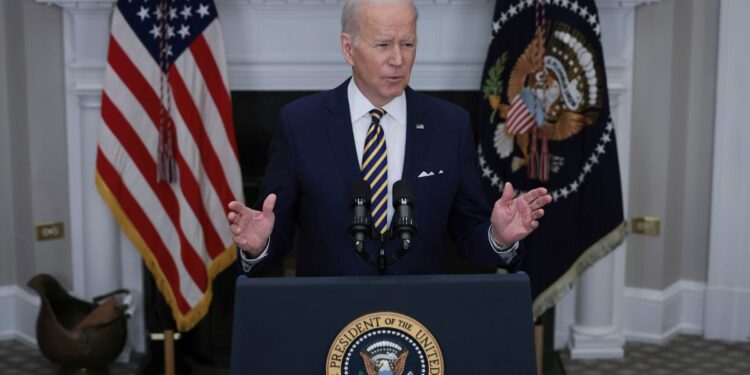Loren Steffy, UH Energy Scholar
As gasoline prices reach record levels across the U.S., President Joe Biden announced the U.S. would no longer import oil, natural gas or other energy products from Russia. The move threatened to drive up gasoline prices, a key inflation accelerator, even as inflation already is at a 40-year high. The ban is an attempt to hit Russian President Vladimir Putin where it hurts, because energy sales account for 60 percent of his country’s gross domestic product. But it also will likely have a severe economic backlash for U.S. consumers.
Earlier this week, I was discussing the other steps the U.S. should be taking to mute the impact of the ban with the University of Houston’s Chief Energy Officer, Ramanan Krishnamoorti. We came up with a half dozen actions — less drastic and more effective than the oil ban — that the administration should take to not only mute the fallout of the oil ban but help us build a more resilient energy policy that could protect against future shocks.
1) Suspend the Jones Act. This maritime law regulates commerce in U.S. waters, requiring that all goods shipped between American ports be transported on vessels built, owned and operated by U.S. owners.
The Jones Act’s impact on domestic energy is profound because no oil tankers are built in the U.S., and most are flagged in foreign countries.
That means that while we can import oil from overseas via tankers, we can’t ship it around the country. On the West Coast and in the Northeast, where there are too few refineries to meet demand, we import gasoline — not oil — from, you guessed it, Russia. Russian oil accounts for just 8 percent of our total imports, or 672,000 barrels a day. But Russia also supplied 21 percent of all our gasoline imports last year, at a cost of $12.8 billion.
Suspending the Jones Act’s provision on domestic oil tanking would allow us to ship gasoline from other parts of the country to tight markets on the coasts.
“We’d rather import gasoline from Russia to Boston than ship it from the Gulf Coast to Boston,” Krishnamoorti said, noting that lifting Jones Act restrictions would “level the playing field” on pump prices around the country. It might not bring prices down, but it would prevent the economic pain from being inflicted disproportionately on certain regions.
The same, by the way, would apply to liquified natural gas, which currently is imported to places like the Northeast from other countries, including Russia, even as we’re touting U.S. LNG exports as the energy savior for Europe.
2) Authorize pipelines. Biden was quick to cancel the Keystone XL pipeline when he took office, which has proven to be a short-sighted sop to green-eyed environmentalists. With West Texas Intermediate crude topping $115 a barrel, oil from Canada is finding other, more environmentally threatening routes to market. Shipping oil on rail cars, for example, poses a far greater environmental risk than pipelines. So blocking pipeline development doesn’t keep oil in the ground, it simply makes it more expensive and increases the chance of catastrophe.
Given the years of back-and-forth on Keystone, it’s possible the line would have been obsolete by the time it opened, but it would kept options open in the current crisis.
Keystone was the most visible, but it isn’t the only pipeline project that’s been stymied. The Atlantic Coast Pipeline, a 600-mile natural gas conduit through Virginia, West Virginia and the Carolinas, was scrapped by Dominion Energy in July 2020 after years of delays and court battles that jacked up the cost by $3 billion or more.
“Permitting for investment in gas transmission and storage has become increasingly litigious, uncertain and costly,” Dominion CEO Tom Farrell told investors at the time. “This trend, though deeply concerning for our country’s economic growth and energy security, is a new reality.”
Indeed, just a few months earlier, Williams Cos. scrapped its proposed Constitution line from Pennsylvania to New York after it became mired in legal, regulatory and environmental battles.
Energy security means energy mobility. Pipelines are unpopular when they’re proposed and built, but largely forgotten once they’re buried and operational. And we need the ability to move our domestic energy sources where the demand is greatest.
3) Review offshore projects in the Gulf of Mexico. The Biden administration put some 80 million acres in the Gulf of Mexico up for lease — the largest offshore auction in history — but it found buyers for just 1.7 million — and a federal judge wound up rescinding even those sales. The judge found the Interior Department acted “arbitrarily” by failing to account for the environmental impact of burning oil produced by the leases in countries outside the U.S. The lawsuit was brought by environmental groups who wanted to halt the sale.
The administration needs to review its leasing policies, and it needs to articulate a clear strategy for offshore drilling. Companies aren’t going to invest billions in new offshore projects if they can’t count on the government to honor its agreements or support energy development.
And while the lease issue focuses on fossil fuels, that’s not the only consideration for the Gulf. It’s poised for an offshore wind energy boom as well, but once again, regulations are bogging down the process. Wind companies are required to conduct complete environmental impact studies, including an analysis of potential underwater issues.
“Forget about anything under the water line,” Krishnamoorti said. Assess the impact on migratory birds and other obvious environmental threats on the surface and get the turbines spinning. Wind projects in the Gulf have the power to generate about 510,000 megawatts annually — more than twice the energy needs of the five states bordering the Gulf.
4) Reach new import agreements with Venezuela and Iran. Sure, Venezuela is a Russian ally, but so is Saudi Arabia these days. If we don’t work on steps 1-3 above, then we’re going to have to deal with someone we don’t like. This has, of course, been both the hallmark and the pitfall of U.S. Energy policies for 50 years. As unpalatable as this move may be, the U.S. simply doesn’t have the ability to ramp up domestic production quickly enough to offset the loss Russian oil. It’s not clear if the Saudis, Venezuelans, and Iranians combined do either. Nevertheless, it makes sense for the administration to keep all avenues open.
5) Push low-carbon hydrogen. Hydrogen has a critical role to play in the future of energy, but right now producing it without carbon capture is cost-prohibitive. So-called green hydrogen, made from the electrolysis of water, costs between $3 and $8 a kilogram. “Blue” hydrogen, made from natural gas, runs between $1.20 and $2.60. It’s little wonder that three-fourths of the world’s hydrogen is currently made by reforming methane or coal gasification, because this “grey” hydrogen costs just 90 cents a kilogram.
The International Energy Agency predicts green hydrogen costs will fall by 30 percent by the end of the decade. We need to fund development that will accelerate that effort. Because the electrolysis can use electricity produced by renewables, green hydrogen is a critical tool in achieving large-scale carbon-reduction goals.
This won’t happen quickly enough to address the current crisis, of course, but it will give us more options in combating the next one. And part of the current challenge is developing better, cleaner ways to enhance our energy security.
6) Rescind tax restrictions and streamline permitting. The most frustrating piece of the entire Russian oil standoff is that we have the potential to do much more at home. The crisis has underscored the dangers of driving too quickly toward an energy transition that relies on energy sources that simply can’t meet current demand. But since taking office, Biden has set a regulatory climate that has discouraged new domestic drilling, even as Wall Street, institutional investors and banks have turned off the flow of capital to the Oil Patch.
At the moment, we need to streamline permitting in the U.S. and make oil and gas more attractive to investors. To be sure, domestic drilling is also hindered by the same supply chain and labor issues that have dogged all U.S. companies as they try to recover from the pandemic. But federal approval for drilling permits takes 140 days, compared with two for the state of Texas. While the Texas Railroad Commission is hardly the gold standard for oil and gas regulation, it shows that it’s possible to move permits along more quickly.
Meanwhile, more than two dozen LNG export projects in North America are stalled, some for eight years or more, because they can’t get the capital needed to complete them.
The administration needs to send a message that the industry is safe for investment. Instead, it’s signaling the opposite. For example, that ruling that canceled the offshore leases? The administration hasn’t appealed. It has, however, appealed a ruling that forced it to hold lease sales in the first place.
It’s also imposing new restrictions on retirement fund managers to assess the climate impact of their holdings, and Biden has appointed Sarah Bloom Raskin to the Federal Reserve, where she wants to use bank regulation to steer capital toward green energy and away from fossil fuels.
So it’s little wonder big energy companies are buying back shares at a record pace — an estimated $38 billion this year. With better policies, that money could have been encouraged to go toward production that would have reduced dependence on Putin’s oil. Instead, the administration’s policies are doing nothing to slake the country’s desperate, immediate thirst for oil and gas.
The challenge posed by climate change requires that we balance short- and long-term concerns. By allowing wishful policies to override real regulatory needs, the administration has stifled the industry just when we need its production most.
We must, as I’ve argued for the past decade, adopt policies that keep our energy options open, to give us flexibility in crises like the ones we now face. It’s not too late. The Biden administration can set policies that balance energy security and energy transition, and the moves outlined above would go a long way toward easing the crisis without forsaking our climate ambitions.
“All of these would have huge impacts,” Krishnamoorti said. They would move us toward a more consistent energy policy, and they would help ease Putin’s stranglehold on our domestic energy markets.
Loren Steffy is a writer-at-large for Texas Monthly, an executive producer for Rational Middle Media and a managing director for 30 Point Strategies, where he heads the 30 Point Press publishing imprint. He is the author of five nonfiction books: “Deconstructed: An Insider’s View of Illegal Immigration and the Building Trades” (with Stan Marek), “The Last Trial of T. Boone Pickens” (with Chrysta Castañeda), “George P. Mitchell: Fracking, Sustainability, and an Unorthodox Quest to Save the Planet, The Man Who Thought Like a Ship,” and “Drowning in Oil: BP and the Reckless Pursuit of of Profit.” His first novel, “The Big Empty,” was published in May 2021.
Steffy is the former business columnist for the Houston Chronicle and previously was the Dallas (and Houston) bureau chief and a senior writer for Bloomberg News. His award-winning writing has been published in newspapers and other publications worldwide. He has a bachelor’s degree in journalism from Texas A&M University.
UH Energy is the University of Houston’s hub for energy education, research and technology incubation, working to shape the energy future and forge new business approaches in the energy industry.











